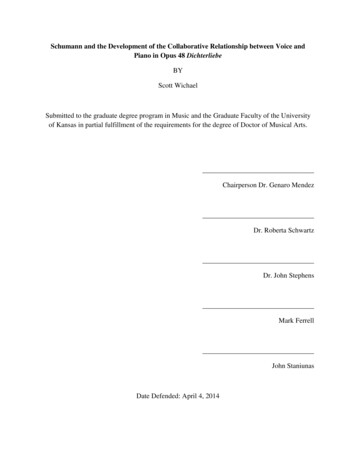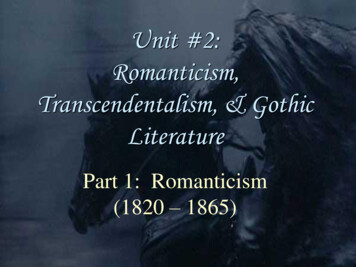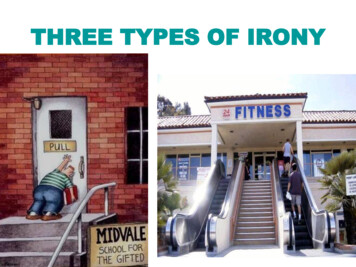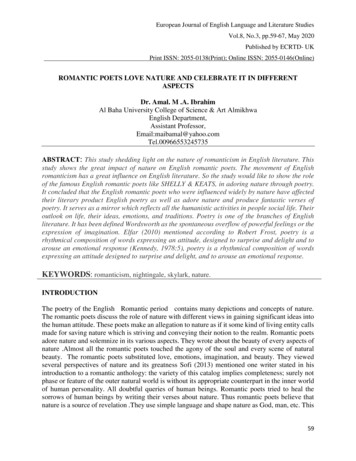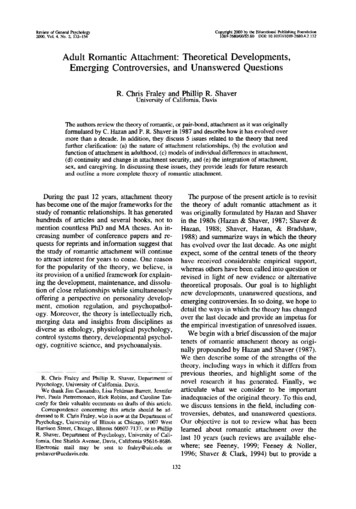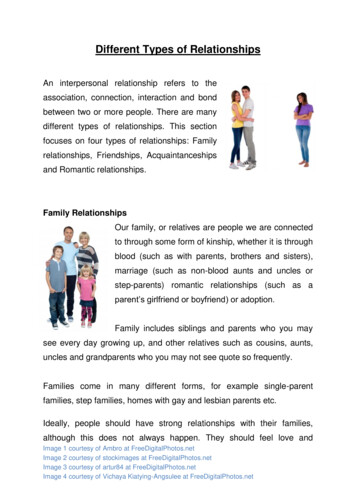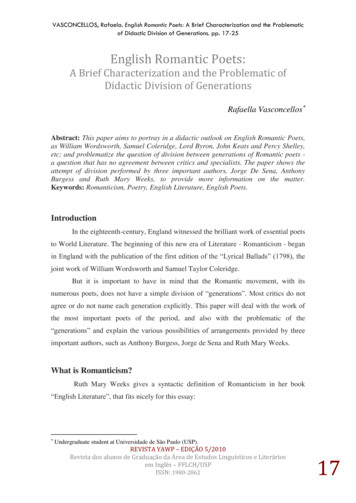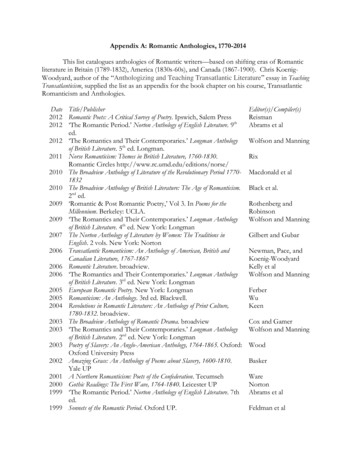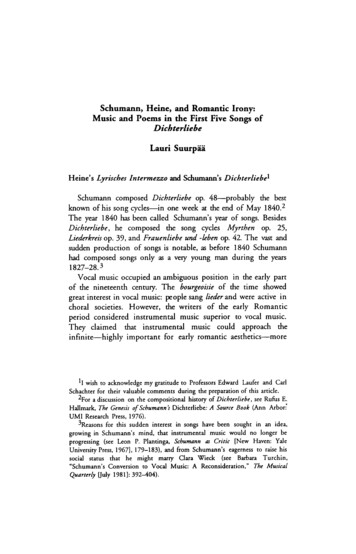
Transcription
Schumann, Heine, and Romantic Irony:Music and Poems in the First Five Songs ofDichterliebeLauri SuurpaaHeine's Lyrisches Intermezzo and Schumann's Dichterliebe Schumann composed Dichterliebe op. 48 - probably die bestknown of his song cycles - in one week at the end of May 1840.2The year 1840 has been called Schumann's year of songs. BesidesDichterliebe, he composed the song cycles Myrthen op. 25,Liederkreis op. 39, and Frauenliebe und -leben op. 42. The vast andsudden production of songs is notable, as before 1840 Schumannhad composed songs only as a very young man during the years1 827-28. 3Vocal music occupied an ambiguous position in the early partof the nineteenth century. The bourgeoisie of the time showedgreat interest in vocal music: people sang lieder and were active inchoral societies. However, the writers of the early Romanticperiod considered instrumental music superior to vocal music.They claimed that instrumental music could approach theinfinite - highly important for early romantic aesthetics - moreM wish to acknowledge my gratitude to Professors Edward Laufer and CarlSchachter for their valuable comments during the preparation of this article.2For a discussion on the compositional history of Dichterliebe, see Rufus E.Hallmark, The Genesis of Schumann's Dichterliebe: A Source Book (Ann Arbor:'UMI Research Press, 1976). Reasons for this sudden interest in songs have been sought in an idea,growing in Schumann's mind, that instrumental music would no longer beprogressing (see Leon P. Plantinga, Schumann as Critic [New Haven: YaleUniversity Press, 1967], 179-183), and from Schumann's eagerness to raise hissocial status that he might marry Clara Wieck (see Barbara Turchin,"Schumann's Conversion to Vocal Music: A Reconsideration," The MusicalQuarterly [July 1981]: 392-404).This content downloaded from 128.151.124.135 on Sat, 16 Mar 2019 00:08:07 UTCAll use subject to https://about.jstor.org/terms
lonee.g.,frommotivicrepetitiopoetry. howthe music.In 1823 Heinrich Heine published Lyrisches Intermezzoy acollection of sixty-six short lyric poems from which the words ofDichterliebe are taken. In later editions of these poems Heinemade numerous alterations including the addition of Im For a discussion on the relation of vocal music and instrumental music inthe early nineteenth century, see Carl Dahlhaus, The Idea of Absolute Music,translated by Roger Lustie (Chicago: Chicago University Press, 1989). Quoted in Turchin, "Schumann's Conversion to Vocal Music," p. 401."See Arthur Komar, "The Music of Dichterliebe'. The Whole and its Parts,"in Arthur Komar (ed.), Schumann: Dichterliebe (New York: W. W. Norton,1971), 63-94. It has been suggested that musical factors similar to those foundin the song cycles create, also, the unity of Schumann's early piano cycles. SeePeter Kaminsky, "Principles of Formal Structure in Schumann's Early PianoCycles," Music Theory Spectrum 11/2 (1989): 207-225.'See Christopher Lewis, "Text, Time, and Tonic: Aspects of Patterning inthe Romantic Cycle," Integral! (1988): 37-73; Patrick McCreless, "Song Orderin the Song Cycle: Schumann's Liederkreis, op. 39," Music Analysis 5/1 (1986):5-28; and David Neumeyer, "Organic Structure and the Song Cycle: AnotherLook at Schumann's Dichterliebe, " Music Theory Spectrum 4 (1982): 92-105.This content downloaded from 128.151.124.135 on Sat, 16 Mar 2019 00:08:07 UTCAll use subject to https://about.jstor.org/termsthe
Schumann, Heine, and Romantic Irony 95wunderschonen Monat Mai, the first poem and opening song ofDichterliebe. There is no single continuous narrative throughout thepoems in Lyrisches Intermezzo , but a certain continuity is createdby the awakening and flourishing of love at the beginning, the lossof love and remembrance of past joy in the middle, and theburial of love at the end.There is, however, a clear narrative throughout the first fivepoems of Dichterliebe. At the beginning, love awakens. In thecontinuation, it can develop either into happiness or sorrow. Aftera moment of joy, misfortune - the loss of love - triumphs. Thetexts and translations of the five poems are given here:1. Im wunderschonen Monat MarIm wunderschonen Monat Mai, In the lovely month of May,Als alle Knospen sprangen, when all the buds were bursting,Da ist in meinem Herzen then within my heartDie Liebe aufgegangen. love broke forth.Im wunderschonen Monat Mai, In the lovely month of May,Als alle Vogel sangen when all the birds were singing,Da hab'ich ihr gestanden then I confessed to herMein Sehnen und Verlangen. my longing and desire.2. Aus meinen Trdnen spriessenAus meinen Trdnen spriessen From my tears spring upViel bliihende Blumen hervor, many blooming flowers,Und meine Seujzer werden and my sighs becomeEin Nachtigallenchor . a chorus of nightingales.Und wenn du mich lieb hast Kindchen, And if you love me, child,Schenk' ich dir die Blumen all\ I give you all the flowers,**The poems of Dichterliebe follow each other in the same order as thepoems in Lyrisches Intermezzo, but Schumann has left out many of the poemsin Heine's collection. The first five poems of the Dichterliebe are numbers 1, 2,3, 4, and 7 in the Lyrisches Intermezzo. Originally Schumann set also poems 5and 6 of Lyrisches Intermezzo, but later left them out of the published versionof Dichterliebe, see Hallmark, The Genesis of Schumann's Dichterliebe, p. 125. The English translations are by Philip L. Miller and have been taken fromArthur Komar (ed.), Schumann-. Dichterliebe, pp. 14-23.This content downloaded from 128.151.124.135 on Sat, 16 Mar 2019 00:08:07 UTCAll use subject to https://about.jstor.org/terms
96IntegralUndvordeinemDas Lied der Nachtigall. the song of the nightingale.Fens3. Die Rose, die LilieDie Rose, die Lilie,The rose, the lily,die Taube, die Sonne,Die liebt' ich einst alleI once loved them allthe dove, the sun with ecstatic love.in Liebeswonne ,Ich lieb ' sie nicht mehr, ich Hebe alleineI love them no more, I love onlyDie Kleine, die Feine,die Reine, die Eine\the little one, the dainty one,the pure one, the One.Sie selber, aller Liebe Bronne,She alone, the well-spring of all love,1st Rose und Lilie und Taube und Sonne. is rose and lily and dove and sun.4. Wenn ich in deine Augen seh'Wenn ich in deine Augen seh\So schwindet all' mein Leid und Weh\When I look into your eyesDoch wenn ich kusse deinen Mund,but when I kiss your mouth,So werd ich ganz und gar gesund .then I become wholly well.Wenn ich mich lehn ' an deine Brust,When I lie upon your breastall my sorrow and pain disappear;Kommt's u'ber mich wie Himmeblust,a heavenly happiness comes over me;Doch wenn du sprichst: ich liebe dich,So muss ich weinen bitterlich.but when you say: I love you!then I must weep bitterly.5. Ich will meine Seele tauchenIch will meme Seele tauchenI will dip my soulIn den Kelch der Lilie hinein ,into the chalice of the lily;Die Lilie soil klingend hauchenthe lily shall breatheEin Lied von der Liebsten mein.Das Lied soil schauern und bebena song about my beloved.The song shall quiver and palpitateWie der Kuss von ihrem Mund',like the kiss of her mouthDen sie mir einst gegebenIn wunderbar siisser Stund'lthat once she gave mein a wonderfully sweet moment.10Heine and Schumann's manuscripts have the word Bronne ("spring") butthe published version of the Dichterliebe has Wonne ("joy").This content downloaded from 128.151.124.135 on Sat, 16 Mar 2019 00:08:07 UTCAll use subject to https://about.jstor.org/terms
Schumann, Heine, and Romantic Irony 97The first poem begins from an emptiness; in it love and natureawaken. The love has a longed-for object, "Da hab' ich ihrgestanden I Mein Sehnen und Verlangen" In the second poem, thelonging and uncertainty give way to happiness - the tears becomeblooming flowers and the sighs become a chorus of nightingales.At the end of the poem, the flowers and the chorus of nightingalesare promised to the beloved, if she gives love in return. That lovewould change the longing of the first poem into joy. The thirdpoem is full of joy; here the love seems to be mutual. The firstthree poems show this shift: at first love and nature awakened sideby side, but by the third poem love is on the surface. Nature - therose, the lily, the dove, and the sun - must give way to it. Thebeloved also replaces nature, "Sie selber, aller Liebe Bronne I 1stRose und Lilie und Taube und SonnetThe fourth poem begins in the bliss of love. The beloved hascome closer than in the previous poems. In the first two poems, shewas only mentioned, and was spoken to in request for love. In ththird poem, love was mutual; happiness, however, was declared noto the beloved herself, but to the world outside the two lovers. Inthe fourth poem, the beloved is present as a physical person; hermouth is kissed, and the lover lies upon her breast. But the fourthpoem brings also the first shadows, the first doubts of thedurability of the love. At the end of the poem the tears of thesecond poem return, "Doch wenn du sprichst: Ich liebe dick I So mussich weinen bitterlich" It is interesting to note that after thhappiness of love, bitter tears are brought forth by the confessionof love. I shall return to this contradiction later in thisdiscussion.In the fifth poem, love has been lost. This poem closes thewhole narrative traced by the first five poems. It looks back inmany ways to the earlier poems. In the third poem, nature - whichhad awakened together with love in the first poem - wasabandoned. In the fifth poem, nature is again desired. Thislonging for nature is emphasized by a word-repetition; the lilyabandoned in the third poem is now wished for so that the lovercan dip his sorrowful soul in it. A second word-repetition in thispoem addresses the kiss: the kiss of the fourth poem - there in thThis content downloaded from 128.151.124.135 on Sat, 16 Mar 2019 00:08:07 UTCAll use subject to https://about.jstor.org/terms
ore,beginthatthefifthpoemgoallatertowardhow whichmusicalf ** Komar, "The Music of DichterliebSchumann 's Dichterliebe, pp. 135-14248-51.*2Hallmark,TheGenesisofThis content downloaded from 128.151.124.135 on Sat, 16 Mar 2019 00:08:07 UTCAll use subject to https://about.jstor.org/termsSchumann
Schumann, Heine, and Romantic Irony 99The content of Heine's poems is clearly reflected in the musicitself in Dichterliebe . Pitch-classes B and D are extremelyimportant in the first five songs. They appear at all structurallevels - in the foreground as embellishing notes, in themiddleground as structurally important chords and notes, and inthe background as keys of individual songs. In my view, these twopitch classes are of utmost importance for the narrative of thefirst five songs: they represent the sorrow and happiness of lovewhich are struggling in the poems. B denotes sorrow and Ddenotes joy. This discussion will address ways in which B and Dappear in the first five songs of Dichterliebe, how these pitchclasses relate to the narrative of the poetry, and how the varyingemphasis given to the two pitch classes reflects the various stagesin the struggle between sorrow and joy. When B is beingemphasized in the music, sorrow is on the surface in the poems,and when D is being stressed, joy prevails.13In his article on Dichterliebe, Arthur Komar presents someideas similar to those in this article; most notably, he regards thefirst five songs as a closed group and he sees the increasingemphasis on pitch-class B as a major factor in these songs.14Despite these similarities, my argument differs greatly from Several scholars have shown that in vocal music a single pitch class or anumber of pitch classes may reflect the poetic images or dramatic tensions ofthe text. Edward Laufer has shown that in Brahms's "Wie Melodien zieht esmir" op. 105, no. 1, D mirrors the poetic content of the text of the song(Edward Laufer, "Brahms, Song op. 105, no. 1: A Schenkerian Approach," inMaury Yeston [ed.], Readings in Schenkerian Analysis and Other Approaches[New Haven: Yale University Press, 1977]: 254-272). Carl Schachter hasdiscussed the motivic importance that the pitch-class Fx/G has in Schubert'ssong "Nachtund Trdume" and how the occurrences of this pitch class reflect thcentral image of the text, the image of dream (Carl Schachter, "Motive andText in Four Schubert Songs," in David Beach [ed.], Aspects of SchenkerianTheory [New Haven: Yale University Press, 1993], 61-76). Elsewhere CarlSchachter has noted the importance that pitch-classes Fit and G have in thedramatic unfolding of the music of Donna Anna's first-act recitative and aria iMozart's Don Giovanni (Carl Schachter, "The Adventures of an Ft: TonalNarration and Exhortation in Donna Anna's First-Act Recitative and AriaTheory and Practice 16 [1991]: 5-17).14See Arthur Komar, "The Music of Dichterliebe? pp. 66-67.This content downloaded from 128.151.124.135 on Sat, 16 Mar 2019 00:08:07 UTCAll use subject to https://about.jstor.org/terms
herichsonoextentl5IbuL, p. 75.This content downloaded from 128.151.124.135 on Sat, 16 Mar 2019 00:08:07 UTCAll use subject to https://about.jstor.org/terms
Schumann, Heine, and Romantic Irony 101It is logical that Schumann only hints towards B and D in thefirst eight measures: because B and D point towards the sorrowand happiness of love, they cannot be emphasized before loveawakens. When it does, in mm. 9-12, pitch-classes B and D areprominent.Measures 9-12 consist of a sequence in which the samegesture - auxiliary cadence IV -V-I supporting an ascendingthird in the top voice - appears twice, first in B minor (mm. 910) and then in D major (mm. 11-12) (see Example lc). Examplela shows how B and D are related to the voice leading of the deepmiddleground. B functions as a passing tone between A (m. 8) andC (m. 13) in the bass, and D is an upper third of B. The sixteenthnote B appearing at the very end of m. 12 emphasizes this passingmotion in the foreground. Although B and D are introduced hereside by side, B - the sorrow of love - appears at a deeper structurallevel than D even at this early point in the piece.16The above-mentioned three sections of the first song - thepiano ritornello, the awakening of nature, and the awakening oflove - differ greatly from each other in stability. The pianoritornello is the most unstable of the three. Taken alone, it doesnot define any key. it hints toward F minor, but never reaches atonic in this key. The section in which nature awakens is the mostharmonically stable in the song. There is a harmonic movementV-I and the top voice descends a third Cjl-B-A; the music burstsfrom the unsteadiness of the piano ritornello in the same way asthe flower buds burst in the poem. This descent of a third is not,however, the fundamental line of the song. C hovers at the topvoice of the background throughout the piece. This is made clearl6Komar regards D as more important: "The D major sequence in mm. 1 112 is structurally superior to the B minor prolongation in mm. 9-10, due to thelower register of D (in the bass) and the similarity of the piano figuration of m.12 to the A major figuration in mm. 6 and 8M (Komar, p. 76; see also hisExample 6 on p. 68). I concede the emphasis given to D in the foreground bythe lower register, but I think all the same that B is, as a passing tone,structurally more important.This content downloaded from 128.151.124.135 on Sat, 16 Mar 2019 00:08:07 UTCAll use subject to https://about.jstor.org/terms
102Integral5O- 1:O1-ocN r-' A o - ' / \ I''1- H -115!This content downloaded from 128.151.124.135 on Sat, 16 Mar 2019 00:08:07 UTCAll use subject to https://about.jstor.org/terms
Schumann, Heine, and Romantic Irony 103*-kii *- / m r - "uJI pr- ',i; itj( aRRi-(*tie;x\I 111This content downloaded from 128.151.124.135 on Sat, 16 Mar 2019 00:08:07 UTCAll use subject to https://about.jstor.org/terms
sintroducesBthesepitchclassescremeasures. The second song, like the first one, is in A major. Here the keyis unequivocally stabilized whereas the piano ritornelloquestioned its role in the first song. Example 2 shows the voiceleading of the second song.The beginning of the second song is in many ways related tothe ending of the first. Schumann returns to the Cf, whichhovered in the top voice throughout the first song.18 The first*' Whether A major or Ft minor should be understood as the main key ofthe first song has been addressed by several scholars. Arthur Komar reads Amajor as the main key of the song (Komar, "The Music of Dichterliebe" pp. 6670). Judging from Schenker's voice-leading sketch of mm. 1-8, this wouldseem to be also his interpretation (Heinrich Schenker, Free Composition, trans,and ed. Ernst Oster [New York: Longman, 1979], Fig. 110c2). This reading which is also my interpretation - is supported by the fact that only A major isconfirmed in the song by a cadence. David Neumeyer suggests that the first twosongs form a pair whose key is A major. He continues, however, that if the firstsong is taken by itself he somewhat favors F§ minor, but that he interprets thesong as actually in both F* minor and A major (Neumeyer, "Organic Structureand the Song Cycle," pp. 103-104). Charles Rosen has argued that the entirequestion of the main key of the song is misguided, writing: "It should beobvious that the contrast of Ft minor and A major is only a surfaceopposition. Schumann treats the relative minor here and elsewhere as a variantform of the tonic, using it rather for a change of mode and not of tonality"(Charles Rosen, The Romantic Generation [Cambridge, Massachusetts: HarvardUniversity Press, 1995], p. 47). In my view it is problematic to interpret a toniccomplex that contains two centers, since the very concept of a tonic key denotesonly one center. Furthermore, it is difficult to interpret Ft minor as a center,since the "key" of Ft minor is represented in the song only by its dominant. Foran illuminating discussion on apparent tonal centers, see Carl Schachter,"Analysis by Key: Another Look at Modulation," Music Analysis 6/3 (1987):289-318, especially 294-298.18Komar reads the Ct as a passing tone between B of the last measure of thefirst song and D in m. 2 of the second (Komar, "The Music of Dichterliebe ," p.72). I do not share this idea, as I believe Ct is retained from the first song.This content downloaded from 128.151.124.135 on Sat, 16 Mar 2019 00:08:07 UTCAll use subject to https://about.jstor.org/terms
Schumann, Heine, and Romantic Irony 105Example 2. Voice leading sketch of "Axis meinen Tranen spriessen . "3n.n.2Y @ @ Ib a 3\fj' rep)21i6-prg.A( i(ml)5iv.S"Vic ) 321pr - - \(10I-8-10-8WPtForm:(ffl»)AlBIVVIJA2This content downloaded from 128.151.124.135 on Sat, 16 Mar 2019 00:08:07 UTCAll use subject to https://about.jstor.org/terms
hichtraIntheBsectionbeloved, and asks for her love, "Und wenn du mich lieb hastKindchenT He would give all the flowers and nightingales thatcame from his tears and sighs if she loved him. Here two factorscreate the atmosphere of uncertainty of the beloved's love: first,1 "David Neumeyer gives more emphasis to the F f -minor chord heard in themiddle of m. 1 than I do. In his view the entire first song prolongs a seventhchord on Cl that is resolved at the beginning of the second song to an Ftminor chord, VI of the primary key A major. See Neumeyer, "OrganicStructure and the Song Cycle," p. 104.This content downloaded from 128.151.124.135 on Sat, 16 Mar 2019 00:08:07 UTCAll use subject to https://about.jstor.org/terms(mm
Schumann, Heine, and Romantic Irony 107the emphasized B-minor chord in m. 11, and second, the ending ofthe B section with a Ct-major chord, almost the same chordwhich ended the unstable first song.In the A2 section (mm. 13-17), love and happiness would seemto be victorious: " Und vor deinem Fenster soil klingen I Das Liedder Nachtigall" If the harmonic situation was unstable in measure1, it is now clear in measure 13. The chord is not, however, a pureA-major chord but rather A7, the dominant seventh of the Dmajor chord in measure 14. The applied dominant, the melodictriplet in m. 13, and the register of the bass in m. 14 allemphasize D. Love seems to have triumphed; the doubts of themiddle section and the first song seem to be gone. The D-majorchord also anticipates the key of the third song, the happiest of thefirst five. This stress on D can also be seen at a deepmiddleground level (see Example 2a). The upper voice D is aneighbor note to C# prolonged from the beginning of the song,and the bass voice D supports a structurally emphatic IV.20Although it seems that love has prevailed, the final conflict oflove's sorrow and happiness - pitch-classes B and D - is still to beresolved. The fundamental line of the second song descends to Abut the A is reached only in the piano part in m. 17. The vocalline ends on a strong B in m. 16. Because of this B and theemphasis given to neighboring note Dinm. 14, the endpoints ofthe vocal line are B and D (see Example 3). For an alternate reading of the voice-leading structure of the second song,see Heinrich Schenker, Free Composition , trans, and ed. Ernst Oster (New York:Longman, 1979), Fig. 22 b. The main difference between my reading and thatof Schenker is that Schenker reads an interruption in the song whereas I do not.Schenker therefore, gives structural emphasis to the E-major chord of m. 9 the dividing dominant of his interpretation - and the A7 chord of m. 1 3 - thereturn of the structural tonic in his interpretation - whereas I read the E-majorchord of m. 9 as an upper fifth of A giving consonant support to a passing-toneB and the A7 chord of m. 13 as resulting from a 5-6 progression above the C*attained in m. 12. For a detailed discussion on Schenker's interpretation of thesong, see Allen Forte, "Schenker's Conception of Musical Structure," in MauryYeston (ed.), Readings in Schenkerian Analysis and Other Approaches (NewHaven: Yale University Press, 1977), 3-37.This content downloaded from 128.151.124.135 on Sat, 16 Mar 2019 00:08:07 UTCAll use subject to https://about.jstor.org/terms
108IntegralExample3n.n.3.2DVocalline1B(voice) (piano)The beginning of the third song is, again, closely related to theend of the previous song. The A major end of the second songfunctions as dominant in the D major of the third, and this Dmajor has been anticipated in the second song by the strong Dmajor chord in m. 14. The vocal line also ties the two songstogether. The B in the vocal line of the second song is, in a way,left hanging in m. 16. This B is - in a poetic, not a voice-leading,sense - resolved by the upbeat of the third song.As previously discussed in relation to the text, the third song isthe happiest of the first five. Here love displaces nature, whichawakened by its side in the first song. The beloved also replacesnature, "Sie selber, aller Liebe Bronne 1 1st Rose und Lilie und Taubeund Sonne" Example 4 shows the voice-leading of the third song.D is now emphasized more than in any of the other songs: hereit is tonic. B also appears quite frequently, but, in spite of theemphasis given to it, functions only in the foreground. It serves asa constant reminder of the still unresolved tension betweenhappiness and sorrow. As a foreground phenomenon, it has noinfluence on the basic voice leading; it does not break theillusion of the joy of love prevailing both in the poem and themusic.The juxtaposition of D and B can be heard at the verybeginning of the song. In the first three measures, the third D-Bis repeated three times. Example 4b shows that in spite of thisrepetition, B appears only in the foreground. D dominates thesemeasures: it is a part of die initial ascent D-E-F (see ExampleThis content downloaded from 128.151.124.135 on Sat, 16 Mar 2019 00:08:07 UTCAll use subject to https://about.jstor.org/terms
Schumann, Heine, and Romantic Irony 1094b). Asa foreground event, B is also strongly emphasized in m. 12.But here, too, it has no influence on the voice-leading of thedeeper levels. It is an upper third of a middleground neighboringnote G, and thus basically an inner voice shifted to the top voice.21Example 4. Voice leading sketch of "Die Rose, die Lilie."(jo) (12) (16) (n)3n.n.21(ascent)- -J i q f[ frpi iv5 6 v i0 ascent D-E-FJf 3 n.n. 2 ]\t)I\r-»(rep.)*10-10-10-10Vt ft omar,pfurthertom.16.1doninitialascentofmm.117.This content downloaded from 128.151.124.135 on Sat, 16 Mar 2019 00:08:07 UTCAll use subject to https://about.jstor.org/terms
edominanceocanbeseenfromEx s.This content downloaded from 128.151.124.135 on Sat, 16 Mar 2019 00:08:07 UTCAll use subject to https://about.jstor.org/termsmCom
Schumann, Heine, and Romantic Irony 1 1 1c C "di llh I » r -a. ucc3c u ! 1 1 \) \ ( (7 » iZj r :/ ih yI * 'I - i /' - - \ *i-This content downloaded from 128.151.124.135 on Sat, 16 Mar 2019 00:08:07 UTCAll use subject to https://about.jstor.org/terms
ound." Afterthethepianodescentoposdude, enker,19651),FreeThis content downloaded from 128.151.124.135 on Sat, 16 Mar 2019 00:08:07 UTCAll use subject to https://about.jstor.org/termsp.Comp
Schumann, Heine, and Romantic Irony 113mm. 16-18 there is, in the top voice, a third D- C- B which isrepeated in an inner voice in mm. 1 8-20. In the piano postlude, Bis emphasized so strongly that it is heard to be dominating the topvoice in the last measures of the fourth song. This B alsoanticipates the upbeat of the next song.2 The poem of the fifth song looks backward in many ways. In it,there are two word repetitions, past tense, and the conflict betweenlove's sorrow and happiness is resolved into a victory of sorrow.The music, too, looks backwards: it includes - as does the poem -a repetition of earlier material. It also resolves the conflictbetween B and D - the key of the song is B minor.Example 6 shows the voice-leading of the fifth song. Thebeginning of the song (mm. 1-6) is very close to measures 9-12 ofthe first song, in which love awakened and B and D wereintroduced (cf. Examples lc and 6b). Both sections consist of asequence in which the top voice, moving from B to Fit, issupported by an auxiliary cadence (IV -V-I in the first song andIl7 V-I in the fifth), first in B minor and then in D major. Asmall detail of the similarity between the beginning of the fifthsong and mm. 9-12 of the first is note B which appears in m. 11of the first song and in m. 5 of the fifth, both times as a part of thepredominant harmony of D major. The roles of B and D differgreatly, however, in these two sections. Whereas B and D had anapproximately equal emphasis in mm. 9-12 of the first song, B isnow clearly dominating in the fifth. As the key of the song, B isalready more emphatic than D. Furthermore, the auxiliarycadence leading to B minor is repeated, and the B-minor chordwhich is reached is strengthened by a voice exchange (see Example6b). The auxiliary cadence leading to D major is not repeated,and the D-major chord reached in m. 5 is not strengthened with avoice exchange. Furthermore, the D-major chord of m. 6 is not a Komar shares my view that B dominat
Das Lied der Nachtigall. the song of the nightingale. 3. Die Rose, die Lilie Die Rose, die Lilie, die Taube, die Sonne, Die liebt' ich einst alle in Liebeswonne , The rose, the lily, the dove, the sun - I once loved them all with ecstatic love. Ich lieb ' sie nicht mehr, ich Hebe alleine Die Kleine, die Feine, die Reine, die Eine\ Sie selber .
